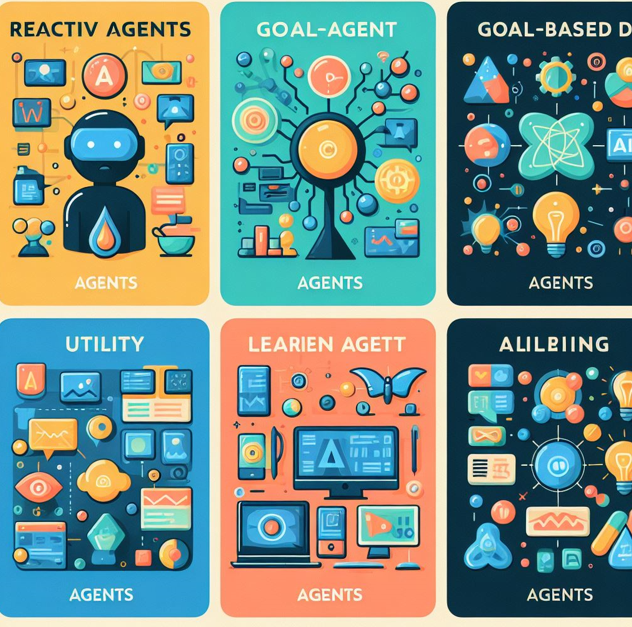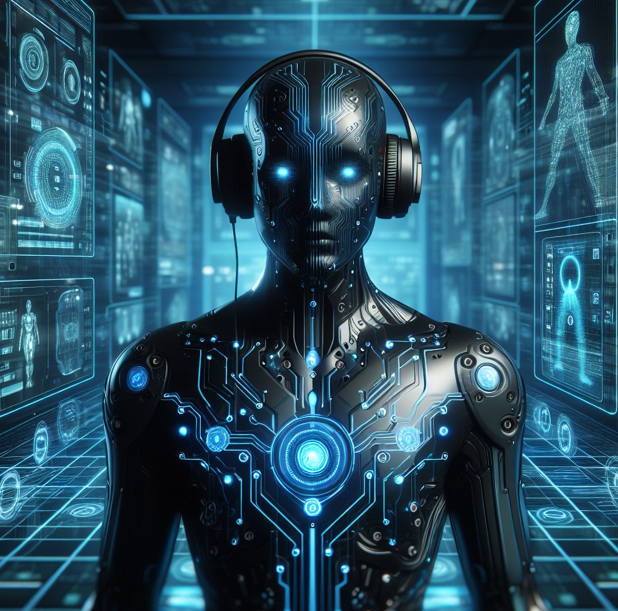What is AI Agent?
An AI agent is a software program designed to interact with its environment, perceive the data it receives, and take actions based on that data to achieve specific goals. These agents can be software-based or physical entities and are often built using artificial intelligence techniques. Here are some key points about AI agents:
- Autonomy: AI agents operate autonomously, meaning they can perform tasks without human intervention. They independently choose actions to achieve predetermined goals.
- Perception: An AI agent senses its environment through physical or software interfaces. For example, a chatbot perceives customer queries as input, while a robotic agent collects sensor data.
- Decision-Making: Based on the collected data, an AI agent makes informed decisions. It analyzes information to predict outcomes that align with its goals and formulates the next action to take.
- Rationality: AI agents aim for optimal performance and results. They act rationally by considering available data and making decisions accordingly.
Benefits of using AI agents include improved productivity, reduced costs, informed decision-making, and enhanced customer experiences. These agents play a crucial role in various domains, from customer service (like contact center AI agents) to self-driving cars navigating obstacles on the road. So, in essence, AI agents are the digital counterparts that help us achieve specific objectives in an intelligent and efficient manner.
Can you give me an example of an AI agent?
Here’s an example of an AI agent:
Virtual Personal Assistants (VPAs): These are commonly used AI agents that assist users with tasks. Examples include:
- Siri: Apple’s voice-controlled assistant that can perform tasks like setting reminders, sending messages, and answering questions.
- Google Assistant: Google’s AI agent available on Android devices and other platforms. It can provide weather updates, set alarms, and even engage in natural language conversations.
- Amazon Alexa: The AI agent behind Amazon Echo devices. Users can interact with Alexa to play music, control smart home devices, and order products.
- Microsoft Cortana: Although its consumer version is no longer available, Cortana was Microsoft’s AI agent for tasks like scheduling meetings, sending emails, and providing recommendations.
These VPAs use natural language processing, machine learning, and other AI techniques to understand user queries and respond appropriately. They’re excellent examples of how AI agents enhance our daily lives! 🤖

What other types of AI agents exist?
There are several types of AI agents, each with distinct characteristics and decision-making approaches. Let’s explore them:
- Simple Reflex Agent:
- These are the simplest agents that make decisions based solely on the current percept (input) without considering the percept history.
- They work using condition-action rules (if-then statements).
- Example: A room cleaner agent that operates only when it detects dirt in the room.
- Challenges: Limited intelligence, lack of knowledge about non-perceptual aspects, and difficulty adapting to environmental changes.
- Model-Based Reflex Agent:
- These agents work in partially observable environments and maintain an internal state (model) based on percept history.
- They track the situation by updating their internal state.
- Consider both how the world evolves and how their actions affect it.
- Goal-Based Agents:
- These agents expand on model-based agents by incorporating goal information.
- They consider desirable situations (goals) and choose actions to achieve those goals.
- May require searching and planning to achieve long-term objectives.
- Utility-Based Agents:
- Similar to goal-based agents but with an additional component: utility measurement.
- They evaluate success at a given state using a utility function.
- Choose actions not only to achieve goals but also in the most efficient way.
- Learning Agents:
- These agents learn from past experiences and adapt automatically.
- Start with basic knowledge and improve through learning.
- Can adjust their behavior based on feedback and changing circumstances.
These different types of AI agents play crucial roles in various applications, from virtual assistants to autonomous vehicles!
How do learning agents work?
A learning agent is a type of artificial intelligence (AI) designed to learn from its environment and improve its performance over time. Here’s how it works:
- Learning from Experience:
- A learning agent interacts with its environment, receiving sensory input (data) and performing actions.
- It learns from past experiences by adjusting its behavior based on feedback.
- Components of a Learning Agent:
- Learning Element: This component makes improvements to the agent’s performance. For example, it might use Q-learning to update its knowledge.
- Performance Element: The performance element selects actions in the environment based on its existing knowledge or rules (similar to a neural network).
- Critic: The critic provides feedback to the learning element, evaluating potential improvements. It helps the agent learn from mistakes.
- Problem Generator: This component suggests actions that lead to new informative experiences (similar to a behavior policy in reinforcement learning).
- Example:
- Imagine an automated taxi:
- The performance element drives the taxi using its existing knowledge.
- The critic observes the world and provides feedback (e.g., after a risky turn).
- The learning element updates the performance rules based on this feedback.
- The problem generator suggests experiments (e.g., testing brakes on different road surfaces).
- Imagine an automated taxi:
- Real-Life Examples:
- Learning agents include humans (who learn skills over time), computer algorithms, and even evolution itself.
Remember, learning agents continuously adapt and evolve, just like we do when learning new things! 🌟🧠
What technologies are commonly used to build AI agents?
When building AI agents, developers leverage a variety of technologies and methodologies. Here are some commonly used ones:
- Machine Learning Algorithms:
- Machine learning (ML) algorithms play a crucial role in training AI agents. These algorithms learn from data and make predictions or decisions based on patterns.
- Examples include decision trees, neural networks, support vector machines, and reinforcement learning.
- Natural Language Processing (NLP):
- NLP frameworks enable AI agents to understand and generate human language. They process text, extract meaning, and perform tasks like sentiment analysis, chatbot interactions, and language translation.
- Libraries like NLTK, spaCy, and Hugging Face Transformers are commonly used.
- Computer Vision Techniques:
- For agents that interact with visual data (images or videos), computer vision techniques are essential.
- Convolutional neural networks (CNNs), object detection models, and image segmentation algorithms are popular choices.
- Reinforcement Learning (RL):
- RL is used to train agents that learn from trial and error. They receive feedback (rewards or penalties) based on their actions.
- Applications include game-playing agents (e.g., AlphaGo) and autonomous robots.
- Pattern Recognition Algorithms:
- These algorithms identify patterns in data, which is crucial for decision-making.
- Examples include k-means clustering, hidden Markov models, and anomaly detection.
- Graph-Based Models:
- Graph neural networks (GNNs) are used for agents that operate on graph-structured data (e.g., social networks, recommendation systems).
- Frameworks and Libraries:
- Developers use popular ML frameworks like TensorFlow, PyTorch, and scikit-learn.
- Cloud platforms (e.g., Google Cloud, AWS, Azure) provide tools for building and deploying AI agents.
Remember, the choice of technology depends on the specific requirements of the AI agent and the problem it aims to solve!
What are some common mistakes to avoid when choosing an algorithm?
When choosing an algorithm for your AI project, it’s essential to avoid common mistakes to ensure optimal results. Here are some pitfalls to watch out for:
- Not Analyzing the Data:
- Failing to thoroughly analyze your data can lead to biased models, missed opportunities, and inaccurate insights.
- Solution: Understand the data context, perform exploratory data analysis (EDA), handle missing data, and assess class representativeness.
- Over-Optimizing Your Model:
- Over-optimization occurs when you fine-tune your model excessively based on historical data (back-testing).
- Consequence: The model may perform well on historical data but fail to generalize to new data.
- Solution: Regularize your model, use cross-validation, and avoid overfitting22.
- Neglecting Risk Management:
- Ignoring risk management can lead to unexpected losses. Consider factors like position sizing, stop-loss, and portfolio diversification.
- Solution: Implement robust risk management strategies to protect your investments.
- Not Monitoring Your Algorithm:
- Set-and-forget approaches can be risky. Regularly monitor your algorithm’s performance and adapt as needed.
- Solution: Continuously evaluate your model, track performance metrics, and adjust parameters.
- Choosing the Wrong Trading Platform:
- Selecting an inappropriate trading platform can impact execution speed, data quality, and reliability.
- Solution: Research and choose a platform that aligns with your requirements.
Remember, understanding your data, model, and risk management are critical for successful algorithmic trading! 🤖💡
How do I build my own simple AI agent?
Building your own simple AI agent can be an exciting project. Here are some steps to get you started:
- Define the Objective:
- Decide what you want your AI agent to do. Is it answering questions, performing tasks, or assisting with specific functions?
- Choose the AI Agent Type:
- Select the type of AI agent that best suits your objective. For example:
- Chatbot Agent: Interacts with users through natural language.
- Task-Based Agent: Performs specific tasks (e.g., scheduling, data analysis).
- Recommendation Agent: Suggests personalized recommendations.
- Select the type of AI agent that best suits your objective. For example:
- Data Collection:
- Gather relevant data if your agent needs training. For chatbots, you might need conversational data.
- Data Preprocessing:
- Clean and prepare your data. Remove noise and irrelevant information.
- Choose AI Algorithms:
- Depending on your task, select appropriate algorithms. For simple agents, rule-based systems or basic machine learning models can work.
- Train the AI Agent:
- If your agent requires training, use your data to teach it how to perform its task.
- Test and Evaluate:
- Test your agent’s performance. Does it achieve the desired results?
- Implement the AI Agent:
- Integrate your agent into an application or platform where it can be used.
Remember, start small and gradually add complexity as you become more comfortable with the process! 🤖🚀
For More Detail

Your writing is like a breath of fresh air in the often stale world of online content. Your unique perspective and engaging style set you apart from the crowd. Thank you for sharing your talents with us.